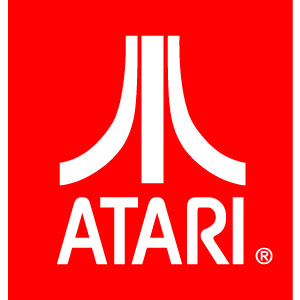Entries Tagged 'trends' ↓
December 27th, 2008 — baltimore, business, design, economics, trends
As many of you know, I live along the shores of the Severn River, a river along the Chesapeake Bay, near Annapolis, Maryland.
This infuriating (but unsurprising) article in the Washington Post suggests that the metrics of its supposed cleanup that have been taking place the last 25 years have been inflated to reflect more progress than has in fact been made.
Just as the advice to an alcoholic on how to lose weight and get back to a normal lifestyle can be nothing other than “stop drinking,” the remedy for the bay is equally stark, though more complex. And the brainless consumer squads inhabiting the Chesapeake Bay watershed want to try every imaginable remedy other than the ones that will work.
If you want to fix the Chesapeake Bay, here’s how:
- Offer massive tax credits for allowing industrial farmland to revert to forestland
- Tax fertilizer sales
- Offer tax credits for replacing industrial farms with grass farms
- Discontinue commercial Blue Crab and fish harvest in the bay; yes, screw the watermen and end the industry
- Tax all impermeable surfaces; tax large impermeable parking lots at a 4x rate
- Use the impermeable surface tax to fund a tax credit for those installing permeable surfaces
- Invest funds in stormwater and sewage handling plants
- Price water at 5x its current price
- Offer tax credits for commuting via bike and public transportation
- Tax credits for people who place land under conservation easement
Got the theme here? It’s all about taxes. While I am not in favor of taxing people, I’m also not especially in favor of large scale programs to modify human behavior. This, however, is exactly what the people say they want, and there’s no surer way to change human behavior than with incentives and disincentives. Taxes and tax credits are arguably the only direct tool that government has to create such incentives for behavior change.
If at least a good portion of these measures are not undertaken (or ones which very much resemble them), I can only assume that — like the drunk who will try every other remedy other than to stop drinking — we are not serious about saving the Bay at all.
Which makes me wish people would shut up and get about their hurried destruction of it; it is the only intent we can infer from the behavior we see. Pave the Bay never sounded so realistic. It really seems as though no one — no one with the will to make a difference — really cares to solve the problem. And I blame us citizenry first and foremost, because we won’t give our elected officials the political cover to do any of the things that it would take to actually solve the problem.
December 16th, 2008 — art, business, design, economics, social media, software, trends, visualization
Last week I had the privilege of attending Le Web ’08 in Paris, which was artfully composed and hosted by Loïc and Geraldine Le Meur. It was an interesting event; I always like getting an international perspective on technology and business.
What was perhaps most interesting was the constructive tension between creativity and business on display there.
The theme of the conference was love — a primary human emotion. However, many of the guests and speakers were aggressive, technically-minded business people. But many of the speakers were artists, musicians, and researchers.
I’m fascinated by the complementary roles of “right brained” activity (art, creativity, design, visual thinking) and “left brained” activity (analysis, rule-based systems, quantitative modeling, finance) in business, particularly on the Internet.
Loïc rightly justified the use of the theme of love for the conference by saying that it is the primary emotion that drives an Internet entrepreneur to give birth to a new idea or technology. Surely this is true, but I’d argue that there are deeper justifications for using an emotion as the theme for an Internet business conference.
Developing innovative Internet business ideas requires a sense of play and real play only comes about when people tap into their creative, artistic brains. Not to get all philosophic, but Immanuel Kant stated in his Critique of Judgement that real advances in art can only be made when art is undertaken for art’s sake alone, that is to say that it is done without any expectation of value, but rather is done merely to satisfy the curiosity of the artist (or designer, or researcher, or scientist).
So, all this means that Internet business people are in desperate need of right-brained influence. It’s where the ideas come from.
My friend Paola Antonelli, curator of architecture and design at the Museum of Modern Art, is quoted as saying, “Good design is a renaissance attitude that combines technology, cognitive science, human need, and beauty to produce something that the world didn’t know it was missing.” Love is surely a human need and is arguably a driver for all good design. And aren’t we all trying to design the things that the world didn’t know it was missing?
William McDonough, famed architect and designer, has stated, “Design indicates intent,” and shouldn’t our intent be to love one another and to love our planet? Isn’t that what we should be trying to achieve in designing our Internet startups?
I was interested to see how many people literally got up and left the plenary session when the subject matter turned to art or music or emotion. Some people were there strictly for left-brained content (how to raise money, how to survive the recession, etc) while others seemed to be more open to the right brained content.
Personally, I enjoyed the presentations by Itay Talgam (conductor), Chris Anderson (curator, TED), Helen Fisher (researcher on human relationships), and Robin Good (on education) the most. I’d say these were the most right brained. Things I enjoyed the least were the presentations by Messrs. Arrington and Gillmor, especially the unfortunate bickerfest that is the Gillmor Group that ended the conference. This is not to say that this kind of “left brained, rule-based” discussion doesn’t have a role, but it doesn’t generate anything really. All it does successfully is tear people apart; it’s not creative, and it doesn’t fuel anybody’s soul.
So, I applaud Loïc and Geraldine for a really creative and fun event, and one which truly gave me a sense of what is currently going on in the heads of European web entrepreneurs. I would simply encourage steering even further into the realm of emotion, creativity, design, and art – as it’s this kind of content which will pull us out of the recession, as it’s this kind of thinking that will help people create art and beauty for art’s sake alone, and these will be the innovations that the world didn’t know it was missing.
Rock on, Loïc, and let your right brain show; it’s your best side.
December 15th, 2008 — design, economics, politics, travel, trends
I just returned from Paris and the formidable Le Web ’08 conference that Loïc and Geraldine Le Meur hosted there, and really had a great time! I will write more about the conference shortly.
Meantime, you may have heard that Paris has installed a network of bicycle stations throughout the city and that they are available for folks to use for their commutes, errands, and to generally replace cars and other forms of transport where possible.
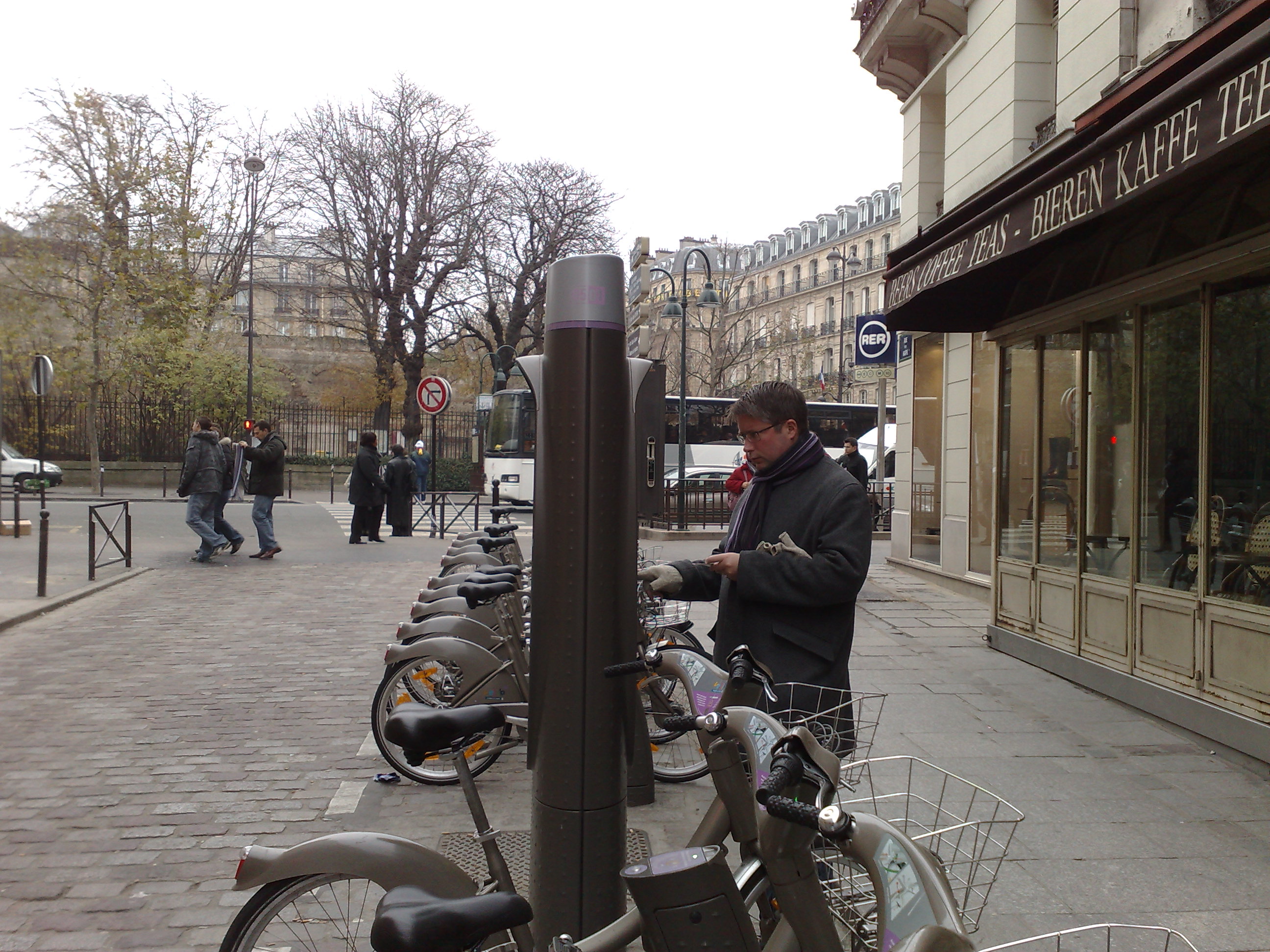
What the press has not reported so well is that these bikes are FREE for trips under 30 minutes (with a very reasonable 1 € /24H subscription), and that it is EASY for tourists to use the bikes. Often, European ticketing machines require credit cards which utilize a smart-card chip, but Paris’ Velib’ bikes have no such requirement.
Here’s how it works:
- Arrive at a bike station and select English as your desired language
- Select “Short term subscription” and choose a 24-hour (1 €) subscription or 7 day subscription (5 €)
- You will guarantee the bike with your credit card for up to 150 €, but you will only be charged if the bike is not returned
- You’ll be given a ticket with a subscription number good for the duration of your subscription
- Follow the directions for taking a bike, and grab one (warning, pick one with good tires and check the seat to be sure it stays up)
- Take a bike
- Return it within 30 minutes and your rental is free!
- Enter your subscription number when you return the bike to confirm the return; the bikes have active electronics that detect the station, so this may not be strictly necessary, but it’s a good idea
Now, at first the requirement to return in 30 minutes may seem like a problem, but it’s not: there are stations every 300 m throughout all of Paris, and you will see these stations everywhere. So, these bikes are great for touring! Bike for a bit, return the bike when you are near your destination or see something interesting, and then walk, train, or meander wherever you like. You can pick up your next bike wherever it’s convenient, and you never have to worry about locking up your bike, leaving a rental bike in a sketchy neighborhood, or having to go back to where you parked your bike. It’s by far the most carefree and fun travel bicycling experience I’ve ever had.
Occasionally, the station where you would like to return a bike is full. If this happens, you can enter your subscription number at the kiosk and it will give you a map of nearby stations (there should be 3-4, as they are placed every 300m). The system also issues you an extra 15 minutes of free time to get to the other station, though in practice 5 minutes is usually all that is required.
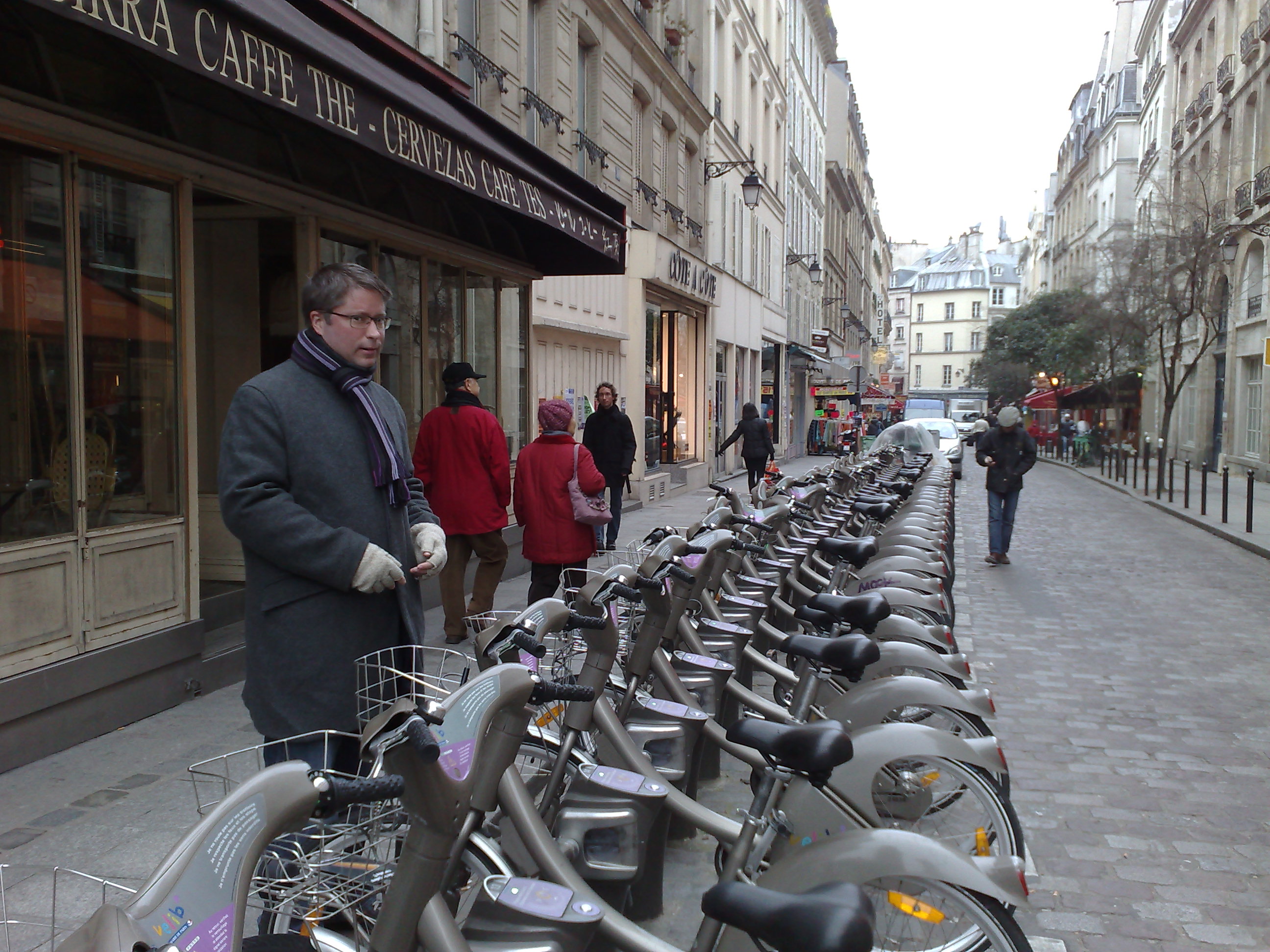
We literally did not think that we were going to use these bikes because so many of the articles we read said things like, “These bikes are not great for tourists because they require a European credit card and cost a lot of money if you keep them all day.” And yes, if you keep the same bike all day, they charge something like 4 €/hour after 2 hours. However, the cure for this is simple: don’t keep the same bike all day. Up to 2 hours the rate is something like 1 € per hour and not nearly as expensive as a traditional bike rental. And who wants to bike for more than a half hour anyway? Paris is all about stopping, checking out unique neighborhoods, grabbing some cheese and wine, and exploring. For this, Paris’ Velib’ (short for Velo Libre — free bikes) is perfect!
Other cities (and counties) should follow Paris’ lead on this. It’s a great system, run by advertising giant JC Decaux in exchange for outdoor advertising rights in Paris. No small trade, but the the benefit to the people of Paris (and to its visitors) of having a well run system for replacing cars is huge. If you have not been to Paris before, this should encourage you to go; if you visit often, please try the Velib’ bikes!
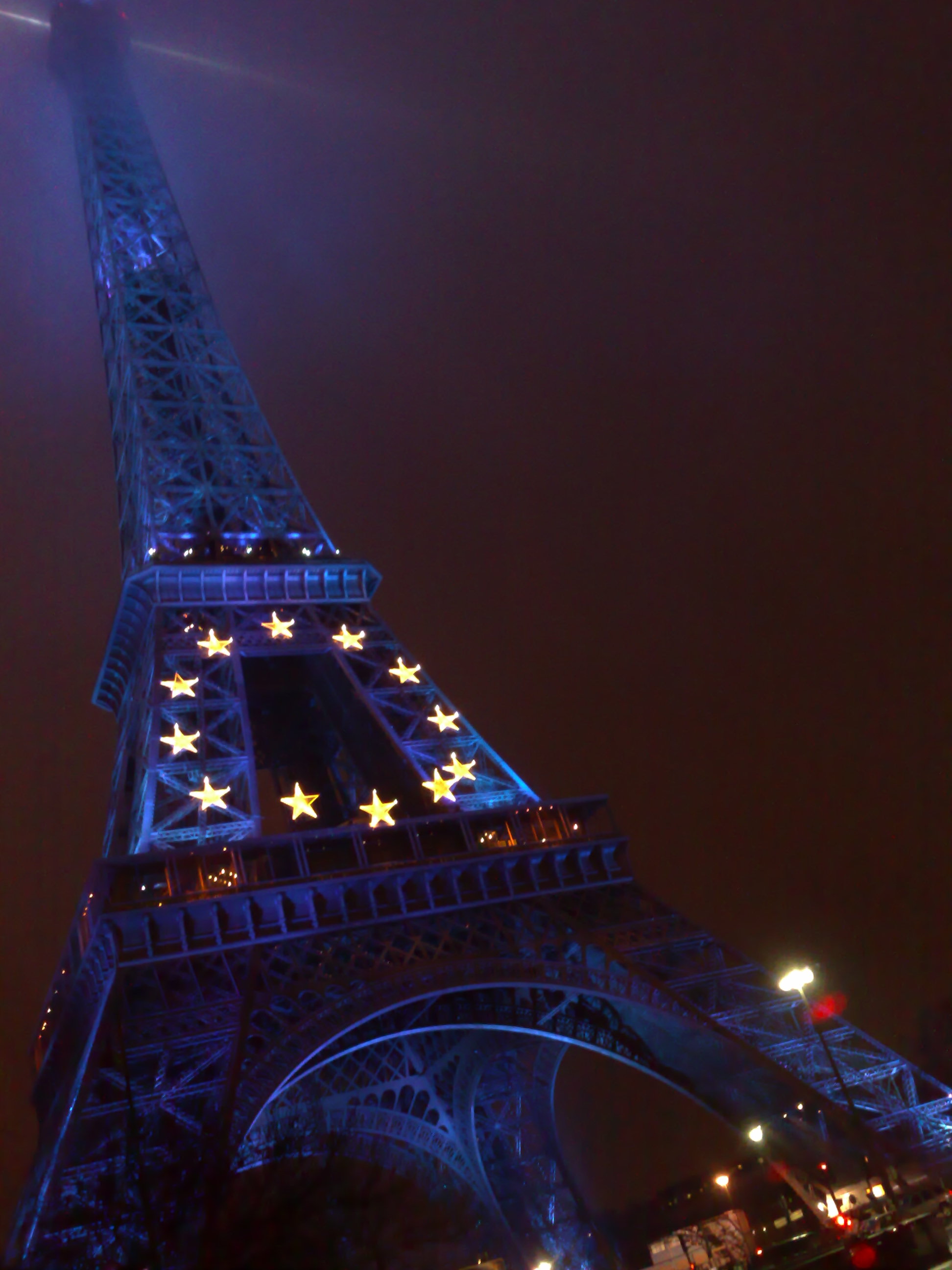
And yes, biking in Paris is somewhat entertaining. While they don’t have as developed a system of bike lane markings as in, say, Berlin, it is functional and you quickly get a feel for where it’s a bad idea to be biking. Shooting across the Seine to the Rue de Rivoli at 9:30 at night proves to be a bit harrowing, but you have the right of way and people are genuinely interested in not killing you; it would be a bureaucratic nightmare for everyone involved.
So, I can’t recommend it highly enough. Go to Paris, grab a bike, and have a great time!
November 23rd, 2008 — art, design, software, trends
I was 5 years old in 1977, and all-in-all, I’d say the aesthetics of the day made a big impression on me. Here are some of the things that, looking back on it 31 years later, seem to share a common visual language and which were most influential on the next 10 years in movies, computing, games, and package design.
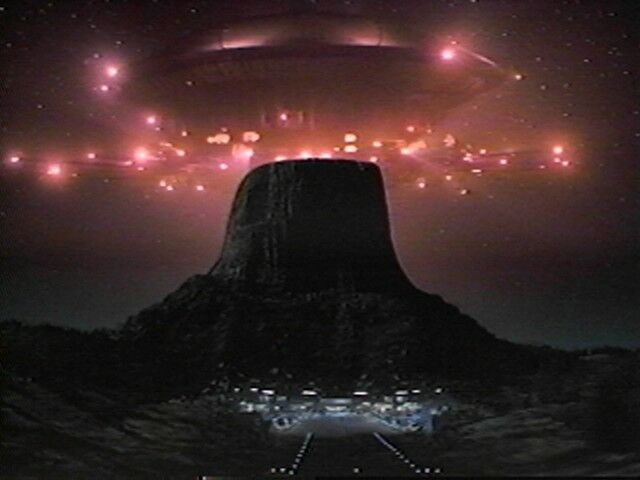
The rich colors and ground-breaking special effects of Spielberg’s 1977 Close Encounters of the Third Kind marked the beginning of a new era in filmmaking and ultimately set a goal for computer graphics and video games. The nascent digital graphics industry was barely capable of producing color “high-res” graphics, but folks knew that when they could, these were the kinds of graphic effects they wanted to make.


Maybe it’s just me, but it seems to me that Close Encounters, Atari, Space Invaders, and Star Wars were all linked together with a common visual sense. I think it’s pretty obvious that Atari ripped off Close Encounters for the Space Invaders packaging.
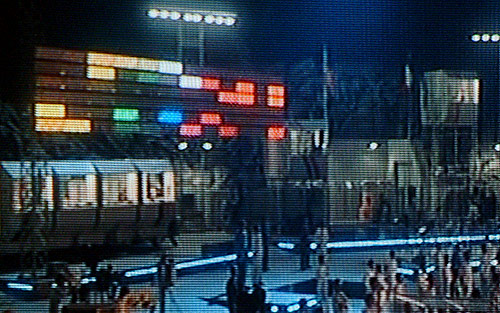
Likewise, the colorful “light organ” used to communicate with the aliens in Close Encounters is a close cousin, visually, to the famous Atari game Breakout. Steve Jobs was one of the designers of the arcade version of Breakout. Note the similarity to the original “rainbow” Apple logo.

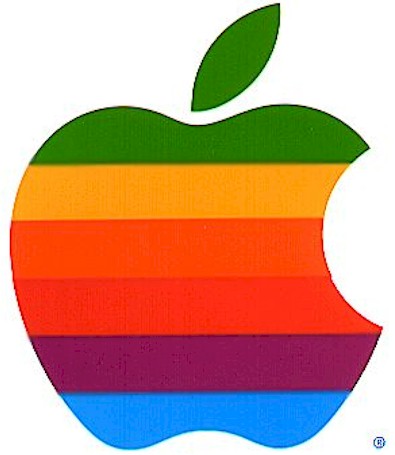
Computer-generated music and sound was still in its very earliest stages, but the simple John Williams melody put to such brilliant use in Close Encounters was the sort of musical coda that aspiring game designers and programmers could latch onto and reproduce. John Williams of course scored hit after hit in movie soundtracks, but the Close Encounters and Star Wars themes of 1977 were hugely influential.
Spielberg used the Rockwell International logo (center) to clever aesthetic effect in Close Encounters; contractors at the secret military base at Devil’s Tower sported it, visually quoting the Devil’s Tower landscape. Of course, it’s interesting to note how similar the logos are for Atari, Rockwell, and Motorola – all major corporations of the day.

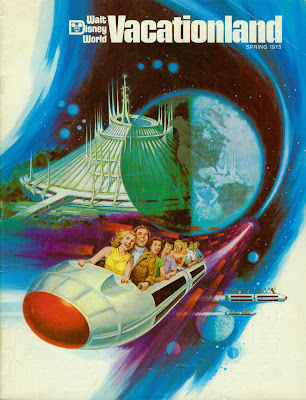
Disney got into the act in 1977 with the opening of Space Mountain. While they may not have been directly influenced by imagery from Close Encounters, Atari, or Star Wars, it’s clear that the popular imagination was drawing from common influences like Kubrick’s 2001: A Space Odyssey from 1969.
Of course the biggest influence of 1977 was George Lucas’ seminal work, Star Wars, which interestingly was not initially marketed using its iconic title graphics in its movie poster. It took a little while, and for the film to settle into its status as an international blockbuster, for it to adopt the visual marketing language that would become familiar in the release of the subsequent films in the series.
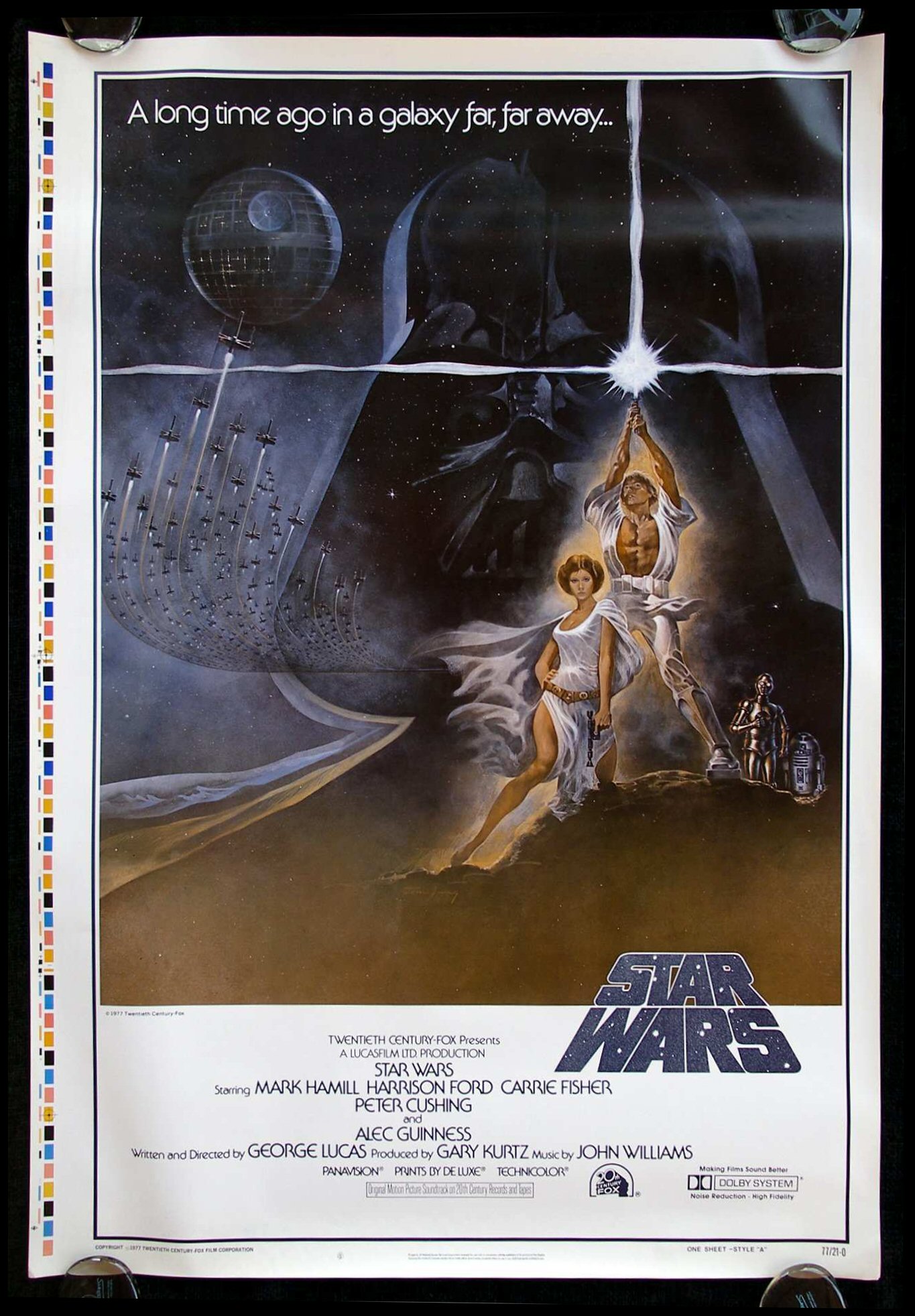
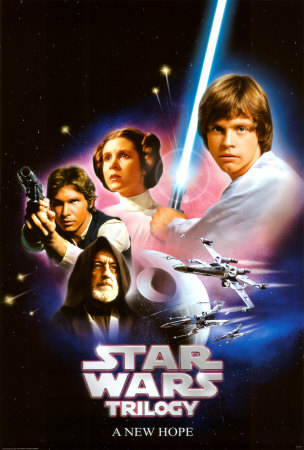
Arguably, the latter sans-serif Star Wars bubble letters were more inline with the iconography of Close Encounters, Atari, and the other major visual influencers of 1977. I’d bet the previous, blockier Star Wars graphic was designed in 1975 or 1976, before the film and its title graphics were completed. And the very earliest Star Wars art from the 1973-1974 timeframe used a hand-drawn serifed font — a different look altogether.


The dirty, realistic “used universe” designed for Star Wars was also influential. Unlike previous science fiction and space films, Lucas imparted his universe with a lived-in, beat-up look that added a romantic touch of decay to an imagined future — or past.
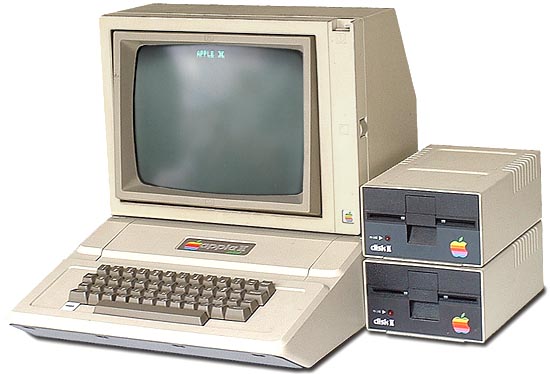
The Apple ][ was a direct result of Jobs’ (and Wozniak’s) work on Breakout, and the color graphics circuitry has much in common. And I don’t think it’s any stretch to say that the generation of Silicon Valley idealists that designed the Apple ][ and Atari 800 were hugely influenced by the blockbuster science fiction films of the day. While the early Apple designs lacked sufficient economy of scale or budget to have a very “designed” aesthetic, the Apple II does look like something straight out of the Star Wars universe. And the ugly Disk ][ and portable monitor are things that just didn’t get attention yet. Maybe they’re dirty, lived-in artifacts of a galaxy far, far away?
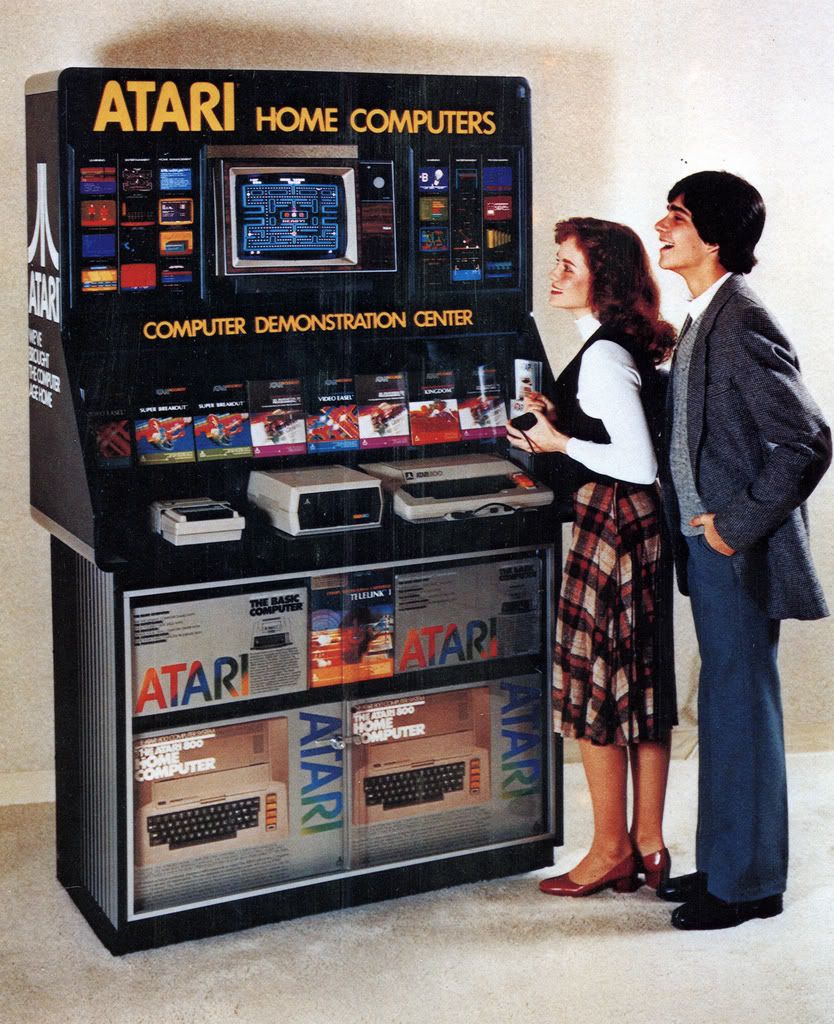
Atari, on the other hand, with the success of the 2600 VCS and its computers, had fully embraced the 1977 aesthetics and by 1980 had full color graphic packaging and a line of “Star Wars” compliant peripherals. And the packaging for the programs borrowed from movie poster designs.
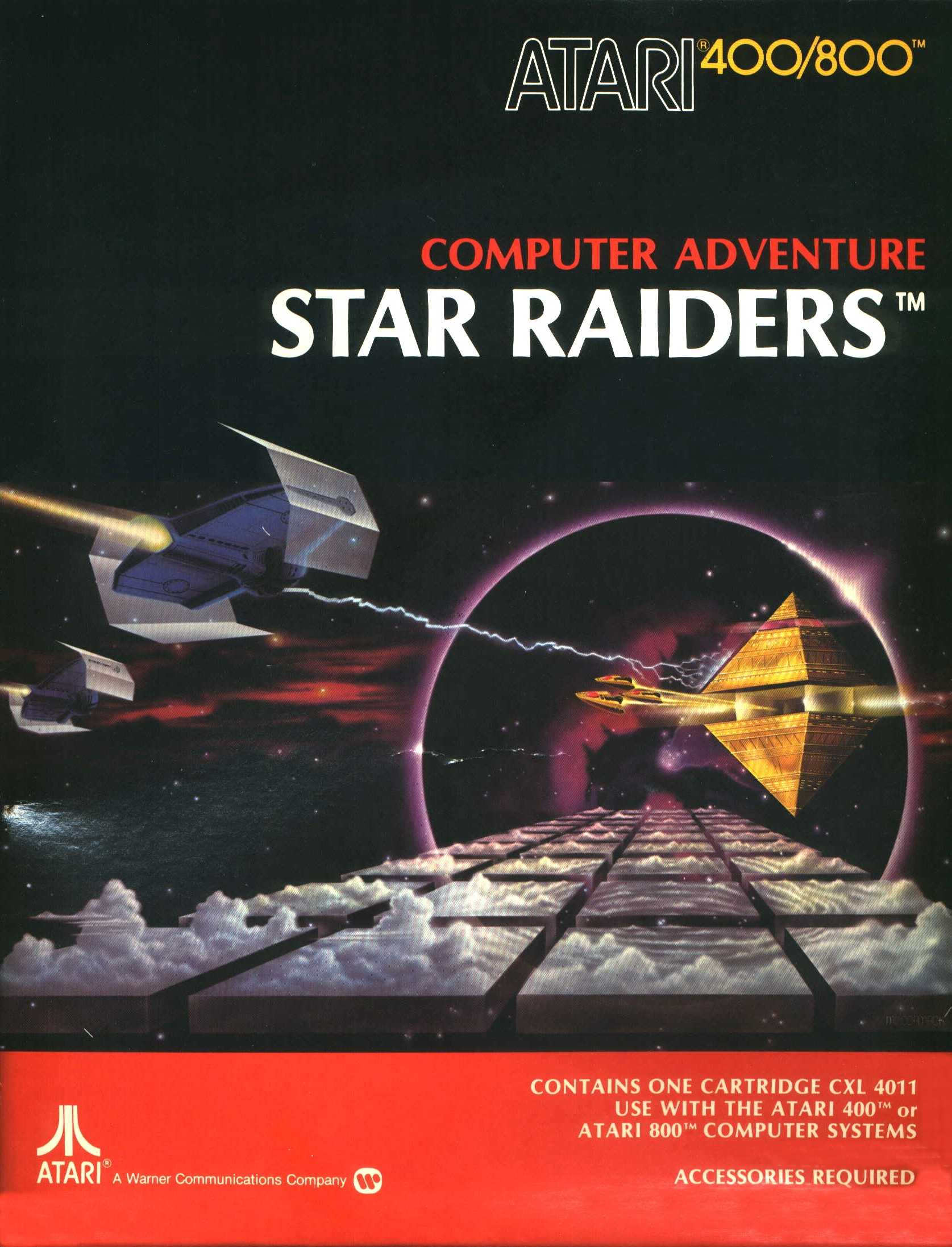
Quite clearly Star Raiders (1979) borrowed directly from Star Wars. In fact, looking at this graphic, I’m now surprised that Atari didn’t get a phone call from Lucas. I guess this was back in the day before tie fighters were Tie FightersTM.
Media critics have argued that Star Wars and Close Encounters of the Third Kind marked the start of the era of blockbuster films, and a general shift in popular culture away from smaller, more thoughtful cinema and towards a populist, anti-intellectual approach in art and film in particular.
Whether that’s true or not, I think it is fair to say that 1977 did mark the year of a seismic shift in aesthetics that has been felt all the way through today in computing, gaming, film, and product packaging. Perhaps 1977 is a kind of bright-line marker for popular art — before and after seem to be from entirely different eras.
The fact that I’ve spent most of my life selling products or working in technologies directly influenced by this powerful aesthetic sense is likely no coincidence: to be young in 1977 was to be indelibly marked by the look and feel of a new era.









